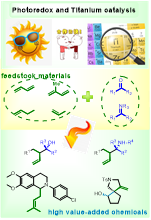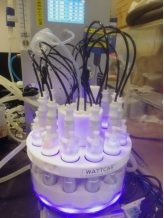Date:Oct 30, 2020
Recently, the research team led by Prof. Lei Shi from Zhang DaYu School of Chemistry in Dalian University of Technology (DUT) has made new advance in synergetic utilization of visible light and titanium for organic catalysis. Their research work “Photocatalytic Generation of π‐allyltitanium Complexes via Radical Intermediates” has been published in Angew. Chem. Int. Ed (IF=12.5), and “Visible-light-driven Spirocyclization of Epoxides via Dual Titanocene and PhotoredoxCatalysis” has been published in Chemical Science (IF=9.5).


Homoallylic alcohols and their derivatives are important building blocks for the synthesis of various pharmaceuticals and biologically active natural products. The addition of various π-allylmetal complexes to carbonylsisone of the mostimportantroute to homoallylic alcohols.However thetediousand uneconomical preparation of sensitiveπ-allylmetal complexesthatrelieson pre-activatedallylichalides and stoichiometric metallicreductants has restricted their widespread application. Shi’s groupreportedthe first photocatalytic generation of π‐allyltitanium complexes via a radical strategy. This novel strategy enables the three‐component allylation of carbonyls with 1,3‐butadiene, providing rapid access to valuable homoallylic alcohols across over 60 examples. The exceptional regio‐ and diastereo‐selectivity provided by dual photoredox/Ti catalysis isunprecedented in the literatures.This study has been published in the top international chemistry journalAngew. Chem. Int. Ed. (DOI: 10.1002/anie.202010780)
The same grouphas developedthe synergistic utilization of titanocene/photoredox dual catalysis driven by visible light for the radical opening/spirocyclization of easily accessible epoxyalkynes. This environmentally benign process uses the organic donor–acceptor 4CzIPN as a photocatalyst and Hantzsch ester (HE) as an electron donor instead of stoichiometric metallic reductants. The photocatalytic conditions showed exceptionally high reactivity for the synthesis of privileged and synthetically challenging spirocycles featuring a spiro all-carbon quaternary stereocenter. Cyclic voltammetry (CV) studies suggest that Cp2TiIIICl is the catalytically active species.This study has been published in Chemical Science(2020, 11, 839-844).
Links to the papers:
Shi’sGroup Webside:
http://faculty.